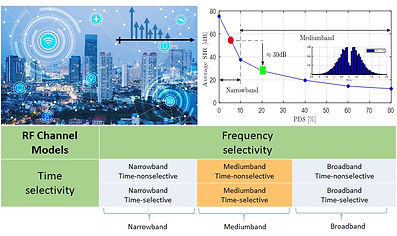Mediumband Wireless Communication


In modern wireless communication systems like 4G, 5G, WiFi, the information bearing signal is a broadband waveform. Using IFFT and FFT blocks at the transmitter and receiver respectively, the broadband waveforms are traditionally designed as a set of parallel narrowband waveforms. However, narrowband waveforms have many drawbacks. Because, their signalling rate is low and are exposed to excessive deep fading.
The research have shown that it is more favourable to make broadband waveforms, not as a set of parallel narrowband waveforms, but as a set of “parallel mediumband waveforms”. Why do these mediumband waveforms matter? It is because, they do signalling at a faster rate, can avoid deep fading and also can afford more interference. Read more about mediumband waveforms below.
Relevant Publications
-
D. A. Basnayaka, "Simulating mediumband wireless communication systems: A concise description," Available online on: https://arxiv.org/abs/2510.13532 (Tutorial paper with MATLAB codes)
-
D. A. Basnayaka and A. Firag, "Integrating mediumband with emerging technilogies: Unified vision for 6G and beyond physical layer," Available on ArXiv, Jan. 2025.
-
D. A. Basnayaka, "Communicating in the mediumband: What it is and why it matters," IEEE Communication Magazine, vol. 62, no. 11, Nov. 2024.
-
D. A. Basnayaka, "Introduction to mediumband wireless communication," in IEEE Open Journal of the Communications Society, vol. 4, pp. 1247-1262, Apr. 2023.
-
A. Firag, J. Jia and D. A. Basnayaka, "A link-level performance analysis for mediumband wireless communication," IEEE Virtual conference on Communications, Dec. 2024.
-
D. A. Basnayaka and P. J. Smith, "The effect of deep fading avoidance in mediumband radio frequency channels," 2023 IEEE 98th Vehicular Technology Conference (VTC2023-Fall), Hong Kong, Dec. 2023.
-
D. A. Basnayaka, "Mediumband wireless communication," 2022 IEEE 96th Vehicular Technology Conference (VTC2022-Fall), London, United Kingdom, Sep. 2022.

Resources
-
A MATLAB code that simulates a basic mediumband wireless communication system (Download)